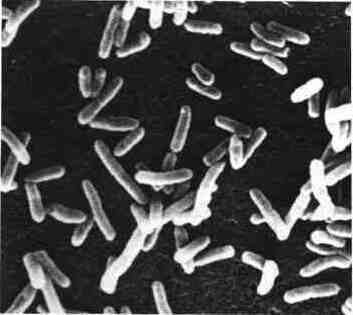I – DEFINITION:
This group brings together Enterobacteriaceae species that share to own enzymes for the oxidative deamination of amino acids into ketones. These form colored complexes with the ions Fe “1” 1 “1”.
Two of these enzymes are sought common. They are:
– Tryptophan deaminase or ADD,
– Phenylalanine deaminase or PDA.
In the rest of this chapter, this group of bacteria will be designated as “TDA Enterobacteriaceae +”. This is a very heterogeneous group. These bacteria are moving generally give lactose-negative colonies are negative ONPG.
II – CLASSIFICATION:
The taxonomic work based on the DNA hybridization reactions showed that:
– Previously identified as Proteus morganii strains do not belong to the genus Proteus They form the genusMorganella..
– Stem designated as Proteus rettgeri are classified within the genus Providencia.
The current classification of ADD + Enterobacteriaceae group is as follows:
– Proteus, 4 species: P. mirabilis, P. vulgaris, P. and P. penneri myxofaciens. The latter has no medical value.
– Gender Providencia, 4 species: P. alcalifaciens, P. stuartii, P. and P. rettgeri rustigianii (close to P. alcalifaciens)
– Gender Morganella, one species M. morganii
III – HABITAT:
TDA + Enterobacteriaceae are widespread in the environment.
They are found everywhere on the floor, in surface waters, sewage etc. These are the usual hosts of the digestive tract of humans and animals.
IV – PATHOGENICITY:
These bacteria are primarily responsible for urinary tract infections. P. mirabilis is by far the most frequent species.Species encountered are then Mr. morganii and Providencia. An abnormality of the urinary apparatus or diabetes are factors favoring the occurrence of these infections that can cause septicemia.
These bacteria are also isolated from different pathological Products: tracheobronchial secretions, burns, various pus. Proteus meningitis have been reported in infants.
The enteropathogenic power of Proteus and Providencia is highly questionable. These species are often present in large amounts in the feces during diarrhea from intestinal dysmicrobism.
Due to the high frequency of Enterobacteriaceae TDA + in the environment, there is still reason to question the quality of the samples before assigning a pathogenic role for isolated strains.
V – PATHOPHYSIOLOGY:
Several factors contribute to the TDA Enterobacteriaceae + Proteus -Providencia group are uropathogenic.
– Urease possessed by most strains transforms urea into ammonium hydroxide. This results in an increase in pH of the urine, which alters renal cells and promotes formation.
– P. mirabilis has pili which increasing their adhesion to epithelial cells favor the occurrence of an ascending pyelonephritis.
– The high mobility of Proteus promotes their dissemination in the urinary tract.
Experimental work has shown that stem contacted with antiflagelles antibody lose their ability to cause ascending infection.
VI – BACTERIOLOGICAL CHARACTERS:
 A – Body type:
A – Body type:
P. mirabilis and P. vulgaris are highly polymorphic bacilli (hence the reference to Proteus). In a youth culture, there may be short forms and long forms. The highly motile strains are provided with long flagella.
B – Cropping characters:
– In broth cultures develop often giving a veil on the surface.
– In agar medium, P. and P. mirabilis vulgaris may invade the surface of the medium, forming concentric circles. This swarming, swarming or is due to the high mobility of the bacteria. The invasion of crops by Proteus can be reduced by the presence in the medium of bile salts or detergent by increasing the content of agar or by a decrease in NaCl content (CLED medium = Cysteine Lactose Electrolyte Deficient).
– Phenomenon Dienes
Cultures by ply-offs of two different strains of Proteus does not interpenetrate and are separated by a narrow zone without culture. This phenomenon can be used to compare the strains isolated from the same hospital sector.
C – biochemical characters:
1. Gender Proteus:
Proteus are characterized by their very active urease (exceptions), the production of H2S gelatinase and low glucidolytique power.
– P. mirabilis is indole (-) and ODC (+)
– P. vulgaris is indole (+) and ODC (-)
– P. penneri is indole (-) and ODC (-), H2S (d) still resistant to chloramphenicol
2. Gender Providencia:
These strains produce indole, but no H ^ S, LDC, ODC, or DHA.
– P. alcalifaciens is urease (-), adonitol (+), and trehalose (-);
– P. rettgeri is urease (+), adonitol (+) and trehalose (-);
– P. stuartii urease is variable, adonitol (-) and trehalose (+);
– P. rustigianii is urease (-), adonitol (-) and trehalose (-).
3. Gender Morganella:
M. morganii is indole (+), ODC (+), urease (+) and H ^ S (-). This species has a very low glucidolytique activity.
VII – ANTIBIOTIC SENSITIVITY:
Enterobacteriaceae + TDA have a natural resistance to colistin and tetracycline.
It is conventional to oppose the “Proteus indole (-)” (generally more sensitive to antibiotics, including beta-lactams) to “Proteus indole (+)” often multiresistant P.. stuartii and M. morganii can pose difficult problems of antibiotic therapy.They are nevertheless generally sensitive to amikacin and third generation cephalosporins. With the exception ofProvidencia strains Enterobacteriaceae TDA + are usually sensitive to new fluoroquinolones.


You must be logged in to post a comment.